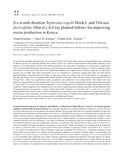| dc.contributor.author | Rutunga, Venant | |
| dc.contributor.author | Karanja, Nancy K | |
| dc.contributor.author | Gachene, Charles K K | |
| dc.date.accessioned | 2013-05-29T08:05:18Z | |
| dc.date.available | 2013-05-29T08:05:18Z | |
| dc.date.issued | 2008 | |
| dc.identifier.citation | Biotechnology, Agronomy, Society and Environment .2008 12(3), 267-278 | en |
| dc.identifier.uri | http://hdl.handle.net/11295/26837 | |
| dc.description | Journal article | en |
| dc.description.abstract | An experiment including planted Tephrosia vogelii and Tithonia diversifolia fallow species and natural fallow was conducted
at Maseno, Kenya, for assessing whether these fallows grown on a nutrient depleted land could produce sufficient green
manure in six month period, whether their biomass retained on the same plots or transferred to continuously cropped plots
with or without added P fertiliser could increase yield of consecutive maize crops and whether it is useful to regularly repeat
these fallows on same plots. First fallow was established in randomized complete blocks with three replicates. At harvesting,
biomass was recorded, then either incorporated in situ or transferred to continuous cropped plots split with and without
added P fertiliser and monitored for the effect in improving consecutive maize crops. The second fallow was managed on
this split plot design. The two-planted shrubs fallows produced more than 9 Mg total dry biomass and accumulated 154 to
234 kg N.ha-1, which were significantly higher compared to the production in the natural fallow. The shrubs were also
superior to natural fallow for P accumulation (5-22 kg versus 2 kg.ha-1). The aboveground dry biomass harvested from planted
T. vogelii and T. diversifolia and either incorporated in situ or transferred into continuously cropped plots increased maize
yields by 2.5 folds compared to the unmanured crop, the control. Supplementing the organic materials with an additional 20 kg
P inorganic fertilizer increased the 1st maize yield by about 40%. Productivity in the plots with T. vogelii or T. diversifolia
aboveground biomass removal was low for the subsequent fallow and maize crops when compared to the performance in plots
where biomass was incorporated. To achieve sustained yields of maize in depleted soils requires regular improved fallowing
at least one season alternating with one season maize, and additional P inputs | en |
| dc.language.iso | en | en |
| dc.subject | Green manure | en |
| dc.subject | Planted fallows | en |
| dc.subject | Maize crop | en |
| dc.subject | Phosphorus addition | en |
| dc.subject | Rotation | en |
| dc.subject | yield | en |
| dc.title | Six month-duration Tephrosia vogelii Hook.f. and Tithonia diversifolia (Hemsl.) A.Gray planted-fallows for improving maize production in Kenya | en |
| dc.type | Article | en |
| local.publisher | Department of Land Resource Management and Agricultural Technology, University of Nairobi | en |

